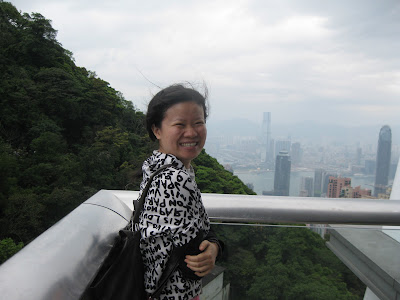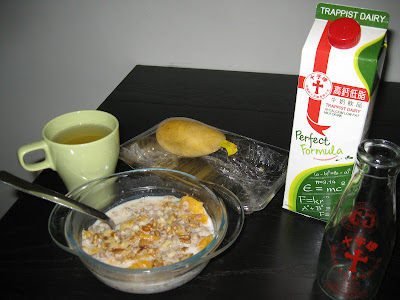China residents have to get a visa to travel to Hong Kong. Yan, a young friend of mine from just across the border in Shenzhen where we lived last year, recently got a Hong Kong visa for the first time. She came to visit on Saturday. She took a bus across the border and then took another bus that dropped her off in Central, the business/financial district on Hong Kong Island. I'd told her I'd meet her outside the Starbucks close to where she got off the bus because I figured if my emailed directions and photos weren't sufficient to help her find it, she'd quickly run into someone who'd know where the Jardine House Starbucks was. She found it fairly easily and was smiling and sipping a latte when I arrived, which made
me smile. I have yet to buy a cup of coffee here in Hong Kong, especially at inflated Central prices. That's fairly easy for me because I usually don't drink coffee, but I'm also reflexively thrifty when it comes to this sort of "extra". And here was my young friend, also careful with her money, splurging and enjoying it. Fun to see.
First on our agenda was doing the most touristy thing that people do in Hong Kong, taking the Peak Tram to the top of Victoria Peak. On the way we walked by one of the handful of surviving colonial buildings in Hong Kong, St. John's Cathedral. This is an Anglican church built soon after the British laid claim to Hong Kong Island in 1842. It's a distinctive old building in the business district, standing in the midst of sleek banks and government buildings. Yan noticed it right away, saw a few people going in the open doors and wanted to go inside, so we did and she took a few photos. She told me she's a Christian, but she'd never been inside a church. This isn't surprising since the Chinese government is twitchy about religion, although there's more freedom in this regard than there used to be, especially in southern China.

Because it was Easter weekend the line for Peak Tram tickets was longer than usual, but when we got closer to the ticket window we jumped to a shorter line for combo tram/Madame Tousard's Wax Museum tickets. I would not have made this choice on my own, but Yan was very sure that she wanted to do this because someone had told her that the museum was a must-see.
The views on the less-than-15-minute tram ride up to the top of The Peak are dramatic. If you're unlucky enough to not have gotten a seat, it's a little more challenging to appreciate the views because the grade is steep much of the way and you're focused on staying on your feet. Fortunately we had seats like these people and could admire in comfort.

Once at the top Yan headed right to Mme Tousard's. She had a ball looking at all the celebrity figures--Chinese, American and British movie and sports stars, musicians, politicians--and had me take dozens of photos on her camera of her posing with many of them. I had thought that once we were done with that we could go outside and take one of the walking paths around the mountain, which I've done before and enjoyed. At 1800', Victoria Peak is the highest point on Hong Kong Island and has superb views of the western side of the island, Victoria Harbor, and Kowloon across the harbor on the peninsula. It's also a lot cooler on the peak. The first British colonialists built their homes up there to escape the summer heat and humidity down below. Yan found it uncomfortably cold on Saturday, though, so after I took this photo of her outside and we did a quick walk to the end of the viewing platform, she was ready to take the tram back down.
As an aside, Terry and I, like other Westerners, notice that our body thermostats are different from those of most Chinese in southern China. When we're comfortable in shirtsleeves, many Chinese are wearing down jackets. When it gets hot and sticky here we're sweating buckets, but most Chinese are barely glowing.

We headed to Stanley Street next, a few blocks up from this food stall area, for lunch at Nam Kee. Terry and I have walked by this restaurant a couple times, but we've never eaten there because it usually has a long line of Central office workers out the door on a weekday. It's known for a great bowl of noodles for less than U.S. $4. On Saturday there were only a couple people ahead of us in line. A tower of just-delivered boxes of dry noodles stood inside the front door. Yan admired them approvingly, took a picture of them and told me that those particular noodles were famous in China. I thought my wonton soup was delicious, but Yan told me outside afterwards that her noodle dish was too sweet. She grew up in an area northeast of Shenzhen and Hong Kong, where the preference is for spicy chili condiment on most everything, instead of the not-spicy and sometimes sweet Cantonese flavors of southern China.

Next we caught the tram that runs east and west along the Victoria Harbor side of Hong Kong Island and went to the Wan Chai area so she could buy presents for family and friends. Most important on her list was 8 bottles of special "medical oil" from Singapore for her mother and grandmother and 6 aunts and uncles. I didn't understand exactly what this oil is used for, but it sounds like sort of a cure-all for aches and pains. She went into quite a few Chinese medicine shops, read lots of labels and compared prices and finally made her purchase at this shop.
We hopped on the tram again and took it practically to the front door of our apartment building on the far west side of Hong Kong Island. I wanted to drop off the present Yan had very thoughtfully brought for Terry and me, a half-dozen bags of various kinds of tea that she'd carefully picked out for us, knowing how much we enjoy this Chinese treat.
After resting a bit and having some water and fruit, we set off to take the Star Ferry across Victoria Harbor to Tsim Sha Tsui in Kowloon, another must-do for tourists. It takes only 5 minutes to cross the mile-wide harbor. This view from the ferry looking back at Hong Kong Island is particularly nice in the evening. The skyscrapers continued to light up as we walked along the promenade on the Tsim Sha Tsui side. I had planned on our staying for the nightly Symphony of Lights at 8:00, when 40-some buildings do a synchronized lights-laser-fireworks-music show. Yes, the tourist checklist again.
But after a quick dinner at a tiny Chinese restaurant up a few blocks from the harbor--Yan specifically said she wanted
rice for this meal--we had to rush to the subway. She told me as we were eating that she had to get to the Sheung Wan station back on Hong Kong Island and then find the nearby ferry terminal so she could buy a ticket and get on the last ferry back to Shenzhen at 8:30. After we had our lunch she'd said that we needed to walk slowly so that our food would digest better. There was no time for slow walking after this meal. We rushed through the subway tunnels, fortunately found helpful signage to get to the ferry terminal, located the ticket window, and then said a hurried good-bye. Yan emailed the next day that she got to the ferry only 5 minutes before departure, maybe just a little bit too exciting an end to her first trip to Hong Kong!























































